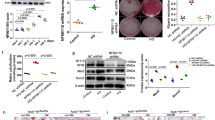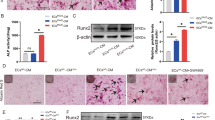Abstract
Aim:
To investigate the effects of advanced glycation end products (AGEs) on calcification in human aortic smooth muscle cells (HASMCs) in vitro and the underlying mechanisms.
Methods:
AGEs were artificially prepared. Calcification of HASMCs was induced by adding inorganic phosphate (Pi, 2 mmol/L) in the media, and observed with Alizarin red staining. The calcium content in the supernatant was measured using QuantiChrome Calcium Assay Kit. Expression of the related mRNAs and proteins was analyzed using real-time PCR and Western blot, respectively. Chromatin immunoprecipitation (ChIP) assay was used to detect the binding of NF-κB to the putative IGF1R promoter.
Results:
AGEs (100 μg/mL) significantly enhanced Pi-induced calcification and the levels of osteocalcin and Cbfα1 in HASMCs. Furthermore, the treatment decreased the expression of insulin-like growth factor 1 receptor (IGF1R). Over-expression of IGF1R in HASMCs suppressed the AGEs-induced increase in calcium deposition. When IGF1R expression was knocked down in HASMCs, AGEs did not enhance the calcium deposition. Meanwhile, AGEs time-dependently decreased the amounts of IκBα and Flag-tagged p65 in the cytoplasmic extracts, and increased the amount of nuclear p65 in HASMCs. In the presence of NF-κB inhibitor PDTC (50 μmol/L), the AGEs-induced increase in calcium deposition was blocked. Over-expression of p65 significantly enhanced Pi-induced mineralization, but suppressed IGF1R mRNA level. Knockdown of p65 suppressed the AGEs-induced increase in calcium deposition, and rescued the IGF1R expression. The ChIP analysis revealed that NF-κB bound the putative IGF1R promoter at position −230 to −219 bp. The inhibition of IGF1R by NF-κB was abolished when IGF1R reporter plasmid contained mutated binding sequence for NF-κB or an NF-κB reporter vector.
Conclusion:
The results demonstrate that AGEs promote calcification of human aortic smooth muscle cells in vitro via activation of NF-κB and down-regulation of IGF1R expression.
Similar content being viewed by others
Log in or create a free account to read this content
Gain free access to this article, as well as selected content from this journal and more on nature.com
or
References
Blacher J, Guerin AP, Pannier B, Marchais SJ, London GM . Arterial calcifications, arterial stiffness, and cardiovascular risk in end-stage renal disease. Hypertension 2001; 38: 938–42.
Guerin AP, London GM, Marchais SJ, Metivier F . Arterial stiffening and vascular calcifications in end-stage renal disease. Nephrol Dial Transplant 2000; 15: 1014–21.
London GM, Guerin AP, Marchais SJ, Metivier F, Pannier B, Adda H . Arterial media calcification in end-stage renal disease: impact on all-cause and cardiovascular mortality. Nephrol Dial Transplant 2003; 18: 1731–40.
Reaven PD, Sacks J . Coronary artery and abdominal aortic calcification are associated with cardiovascular disease in type 2 diabetes. Diabetologia 2005; 48: 379–85.
Covic A, Kanbay M, Voroneanu L, Turgut F, Serban DN, Serban IL, et al. Vascular calcification in chronic kidney disease. Clin Sci (Lond) 2010; 119: 111–21.
Moe SM, Chen NX . Pathophysiology of vascular calcification in chronic kidney disease. Circ Res 2004; 95: 560–7.
Aronson D . Hyperglycemia and the pathobiology of diabetic complications. Adv Cardiol 2008; 45: 1–16.
Chen XF, Lin WD, Lu SL, Xie T, Ge K, Shi YQ, et al. Mechanistic study of endogenous skin lesions in diabetic rats. Exp Dermatol 19: 1088–95.
Schmidt AM, Yan SD, Stern DM . The dark side of glucose. Nat Med 1995; 1: 1002–4.
Vlassara H . Advanced glycation end-products and atherosclerosis. Ann Med 1996; 28: 419–26.
Yamagishi S, Nakamura K, Matsui T, Noda Y, Imaizumi T . Receptor for advanced glycation end products (RAGE): a novel therapeutic target for diabetic vascular complication. Curr Pharm Des 2008; 14: 487–95.
Tanikawa T, Okada Y, Tanikawa R, Tanaka Y . Advanced glycation end products induce calcification of vascular smooth muscle cells through RAGE/p38 MAPK. J Vasc Res 2009; 46: 572–80.
Di Bartolo BA, Schoppet M, Mattar MZ, Rachner TD, Shanahan CM, Kavurma MM . Calcium and osteoprotegerin regulate IGF1R expression to inhibit vascular calcification. Cardiovasc Res 2011; 91: 537–45.
Bierhaus A, Illmer T, Kasper M, Luther T, Quehenberger P, Tritschler H, et al. Advanced glycation end product (AGE)-mediated induction of tissue factor in cultured endothelial cells is dependent on RAGE. Circulation 1997; 96: 2262–71.
Duer MJ, Friscic T, Proudfoot D, Reid DG, Schoppet M, Shanahan CM, et al. Mineral surface in calcified plaque is like that of bone: further evidence for regulated mineralization. Arterioscler Thromb Vasc Biol 2008; 28: 2030–4.
Wallin R, Wajih N, Greenwood GT, Sane DC . Arterial calcification: a review of mechanisms, animal models, and the prospects for therapy. Med Res Rev 2001; 21: 274–301.
Singh R, Barden A, Mori T, Beilin L . Advanced glycation end-products: a review. Diabetologia 2001; 44: 129–46.
Takeuchi M, Yamagishi S . Involvement of toxic AGEs (TAGE) in the pathogenesis of diabetic vascular complications and Alzheimer's disease. J Alzheimers Dis 2009; 16: 845–58.
Yamagishi S . Role of advanced glycation end products (AGEs) and receptor for AGEs (RAGE) in vascular damage in diabetes. Exp Gerontol 2011; 46: 217–24.
Forbes JM, Yee LT, Thallas V, Lassila M, Candido R, Jandeleit-Dahm KA, et al. Advanced glycation end product interventions reduce diabetes-accelerated atherosclerosis. Diabetes 2004; 53: 1813–23.
Ren X, Shao H, Wei Q, Sun Z, Liu N . Advanced glycation end-products enhance calcification in vascular smooth muscle cells. J Int Med Res 2009; 37: 847–54.
Yamagishi S, Matsui T . Smooth muscle cell pathophysiology and advanced glycation end products (AGEs). Curr Drug Targets 2010; 11: 875–81.
Wang Z, Jiang Y, Liu N, Ren L, Zhu Y, An Y, et al. Advanced glycation end-product Nepsilon-carboxymethyl-Lysine accelerates progression of atherosclerotic calcification in diabetes. Atherosclerosis 2012; 221: 387–96.
Komori T, Yagi H, Nomura S, Yamaguchi A, Sasaki K, Deguchi K, et al. Targeted disruption of Cbfa1 results in a complete lack of bone formation owing to maturational arrest of osteoblasts. Cell 1997; 89: 755–64.
Kavurma MM, Figg N, Bennett MR, Mercer J, Khachigian LM, Littlewood TD . Oxidative stress regulates IGF1R expression in vascular smooth-muscle cells via p53 and HDAC recruitment. Biochem J 2007; 407: 79–87.
Valentinis B, Baserga R . IGF-I receptor signalling in transformation and differentiation. Mol Pathol 2001; 54: 133–7.
Delafontaine P, Song YH, Li Y . Expression, regulation, and function of IGF-1, IGF-1R, and IGF-1 binding proteins in blood vessels. Arterioscler Thromb Vasc Biol 2004; 24: 435–44.
Kavurma MM, Bennett MR . Expression, regulation and function of trail in atherosclerosis. Biochem Pharmacol 2008; 75: 1441–50.
Kasukawa Y, Baylink DJ, Wergedal JE, Amaar Y, Srivastava AK, Guo R, et al. Lack of insulin-like growth factor I exaggerates the effect of calcium deficiency on bone accretion in mice. Endocrinology 2003; 144: 4682–9.
Radcliff K, Tang TB, Lim J, Zhang Z, Abedin M, Demer L . Insulin-like growth factor-I regulates proliferation and osteoblastic differentiation of calcifying vascular cells via extracellular signal-regulated protein kinase and phosphatidylinositol 3-kinase pathways. Circ Res 2005; 96: 398–400.
Zhu P, Ren M, Yang C, Hu YX, Ran JM, Yan L . Involvement of RAGE, MAPK and NF-κB pathways in AGEs-induced MMP-9 activation in HaCaT keratinocytes. Exp Dermatol 2012; 21: 123–9.
Zhao G, Xu MJ, Zhao MM, Dai XY, Kong W, Wilson GM, et al. Activation of nuclear factor-kappa B accelerates vascular calcification by inhibiting ankylosis protein homolog expression. Kidney Int 2012; 82: 34–44.
Acknowledgements
The present study was supported by the Natural Science Foundation of Shanghai, China (No 09ZR1425200).
Author information
Authors and Affiliations
Corresponding author
Rights and permissions
About this article
Cite this article
Wang, Y., Zhang, Zy., Chen, Xq. et al. Advanced glycation end products promote human aortic smooth muscle cell calcification in vitro via activating NF-κB and down-regulating IGF1R expression. Acta Pharmacol Sin 34, 480–486 (2013). https://doi.org/10.1038/aps.2012.166
Received:
Accepted:
Published:
Issue date:
DOI: https://doi.org/10.1038/aps.2012.166
Keywords
This article is cited by
-
Role of AGEs in the progression and regression of atherosclerotic plaques
Glycoconjugate Journal (2018)
-
Obesity and type-2 diabetes as inducers of premature cellular senescence and ageing
Biogerontology (2018)
-
Selenoprotein S inhibits inflammation-induced vascular smooth muscle cell calcification
JBIC Journal of Biological Inorganic Chemistry (2018)
-
Effect of morroniside on glomerular mesangial cells through AGE–RAGE pathway
Human Cell (2016)



